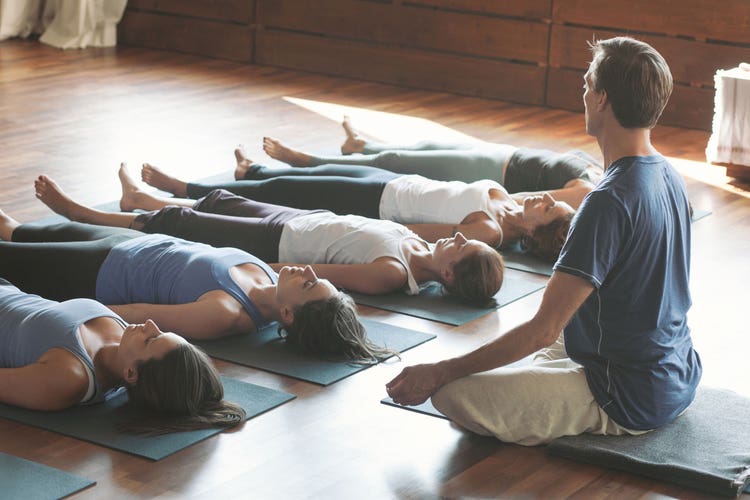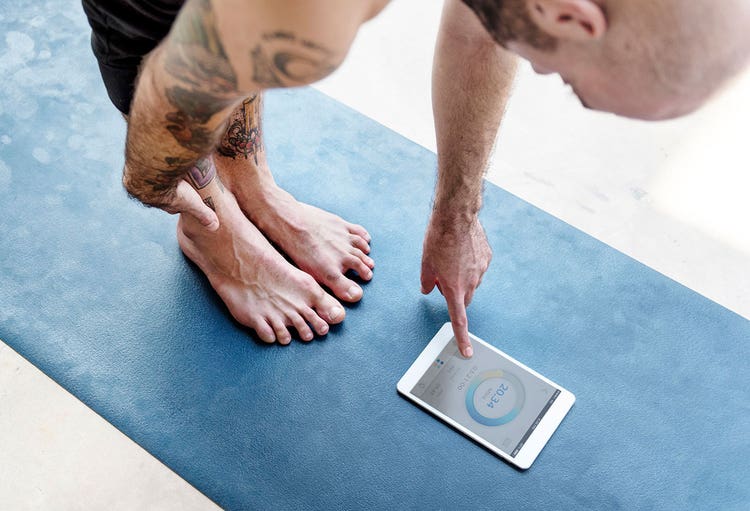Deep Reset: Yoga Nidra

This practice will help you find your way back to being.
The ancient tradition of yoga teaches us that our essential nature is whole, heathy, harmonious and connected. However, in the process of growing up, living our lives, taking on roles and responsibilities, dealing with stress, and incurring various traumas, we’ve lost touch with these innate aspects of ourselves, forgetting our intrinsic wholeness and well-being. Instead, we’ve come to identify with feelings of lack, separation, helplessness, confusion and so forth—no longer experiencing ourselves as the complete, connected and limitless beings that we are.
Yoga is the journey back to self. It is a process of undoing—or unidentifying with—self-limiting notions and reconnecting with all parts of your innate self, helping you to remember your basic wholeness and reawaken to your inner wisdom and power.
The felt-sense of being

There is a deep, peaceful state of stillness within each of us—a calm, abiding presence unaffected by life’s external circumstances, an inner sanctuary at the very core of our being. However, rather than a place, it’s a feeling—the universal feeling, or “felt-sense” experience, we all have when we are simply being.
Pause for a moment. Gently close your eyes and deepen your breath, softening your skin with every exhale. Feel what’s touching the chair, and let your legs become heavy. Without stealing from your base, lightly lengthen up through your spine and soften your back, releasing your jaw and the muscles of your face. Drop the need to do or fix anything. Allow yourself to just be present in the moment. Let yourself linger for a moment in the vast, open spaciousness of beingness.
This is the felt-sense of being. When we experience the felt-sense (or meaningful bodily sensations) of being, we uncover aspects of our selves that we’ve long forgotten. We have glimpses into our true nature, discovering a deep state of stillness and wholeness already present within—feeling complete, connected and at peace just as we are in this very moment. All of this flows from allowing ourselves the experience of being.
The gift of yoga nidra

The good news is that you are already being. You don’t have to do or become anything; you simply have to allow yourself to be. This is, of course, easier said than done considering we are a society of productive doers. Most of us know how to get things done. It’s the not doing we struggle with; it’s the just being that’s difficult.
Enter the practice of yoga nidra. Designed to give you a direct experience of your essential nature, yoga nidra is a powerful meditation technique that guides you into the experience of being, providing the right conditions and context for your true self to naturally unfold.
During yoga nidra, you enter into a state of profound relaxation that is deeply healing on multiple layers of your being (physical, energetic, emotional, intellectual and spiritual). The practice calms the mind, relaxes the body, rebalances the nervous system and restores your connection within. This meditation technique is thus practiced for a variety of reasons, including overcoming anxiety, reducing chronic stress, sleeping better, processing difficult emotions, reducing PTSD, and experiencing a greater sense of harmony and well-being.
Easy and accessible, the practice of yoga nidra is always guided, incorporating stages of body and breath awareness, emotional awareness, exploration of unconscious beliefs and programming, and visualization, which takes you into a deep, meditative state of consciousness. In Sanskrit, “nidra” means sleep; yoga nidra (a form of conscious sleep) induces a profound state of receptive relaxation in which the body and mind are completely relaxed. You remain awake yet completely detached, listening to the instructions throughout the process.
How yoga nidra works

Lying comfortably on the floor, you will be asked to first set an intention, or “sankulpa,” for your session. This is a short, positive statement in present tense said three times internally at the beginning and end of your practice and meant to give meaningful purpose to each yoga nidra session.
After a brief centering, you will be prompted to move your awareness through the body as you lie perfectly still. Beginning and ending in a particular order, yoga nidra follows a specific pattern through various parts of the body as they are neurologically mapped in the brain. That neurological map is often referred to as the “cortical homunculus” or somatotopic arrangement; basically it’s a map of sensory and motor functions of the body to points on the brain and central nervous system. You can think of it as representing the physical body on the brain, a complex map correlating to the sensory and motor areas of the cerebral cortex. As your awareness moves through these areas of the body, you’re calming the sensory and motor regions of the cerebral cortex, deeply relaxing the mind and the body.
By the time you’re done with stages one and two, the body scan and breath awareness portions of the practice, you are in a complete state of beingness—open, receptive, soft and spacious. The remaining stages of yoga nidra involve tapping into and welcoming all thoughts, feelings, emotions and memories, holding whatever arises in your awareness without judgment, without trying to change it or push it away, just being with whatever bubbles up to the surface.
Yoga nidra is a practice of profound welcoming—not suppressing or denying anything— and greeting all aspects of yourself with loving kindness, allowing you to release deeply held emotions and unconscious thought patterns. It allows you to reconnect to all those places judgment has cut you off from and return to your basic wholeness of being.
Where to find and try yoga nidra

Guided yoga nidra is an easy and accessible technique to do at home. No yoga or meditation experience is required. All you need is a recorded guide, a little bit of time and to get comfortable. You can find guided yoga nidra sessions on YouTube as well as a number of yoga sites (just search “yoga nidra online”). There are also a number of yoga nidra apps and meditation apps with yoga nidra practices. Even iTunes has a few free yoga nidra tracks for download.
Sessions are generally 15 to 20 minutes, but they can be as short as 5 to 10 minutes or longer than an hour. You want to be as comfortable as possible, so wear soft clothes and grab some pillows for support and a blanket in case your temperature drops. If lying on the floor isn’t accessible, feel free to lie on a bed or sit in a chair. And don’t stress if you fall asleep. It happens to almost everyone. Your subconscious brain is still receiving the message.
Photo credits (in order): Julien Balmer, Stocksy; fizkes, Adobe Stock; Julien Balmer, Stocksy; fizkes, Adobe Stock; rawpixel, 123RF